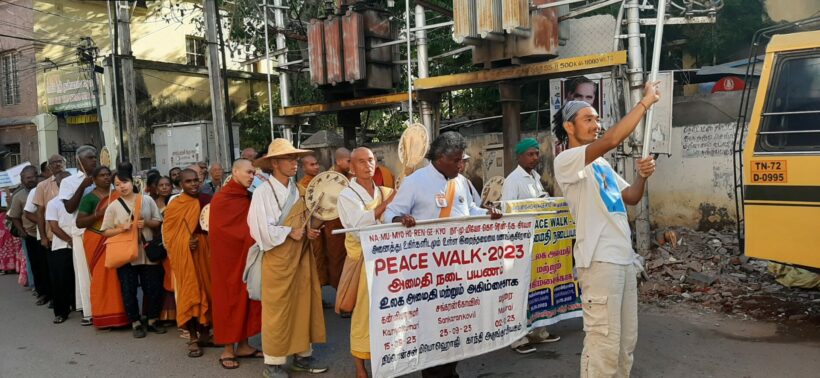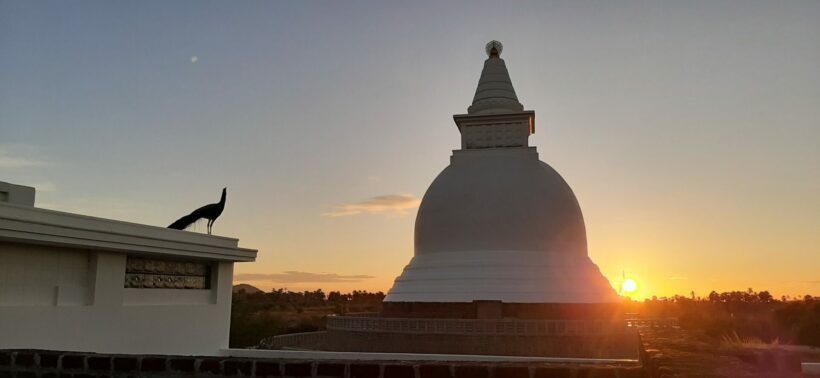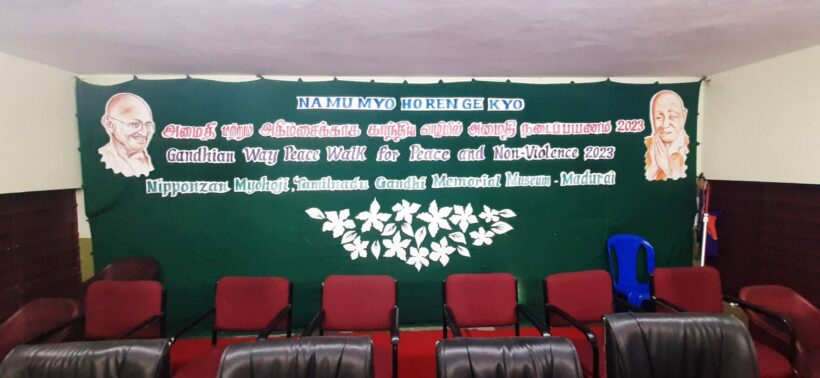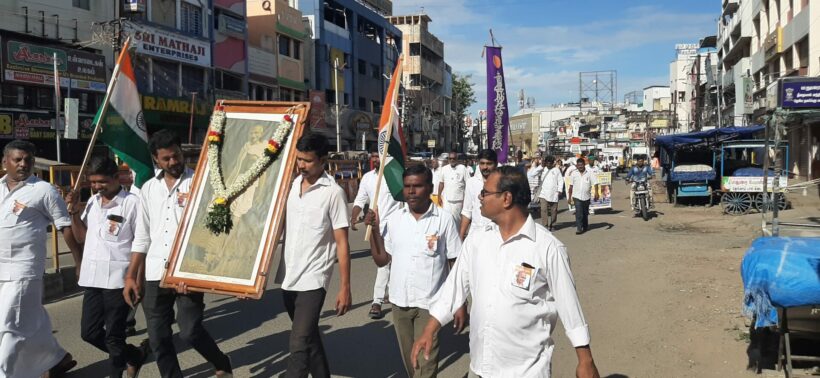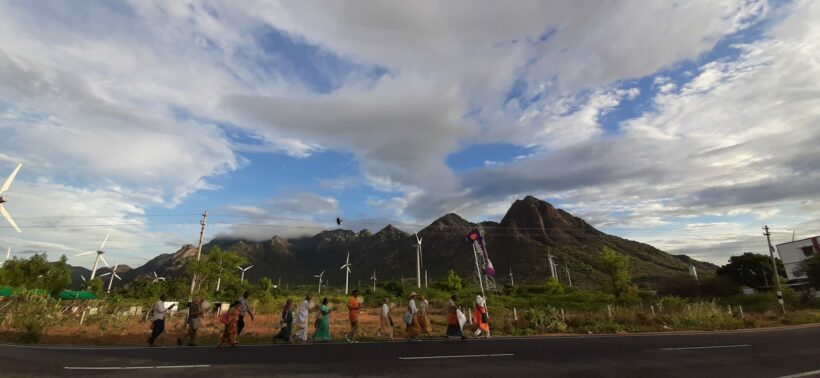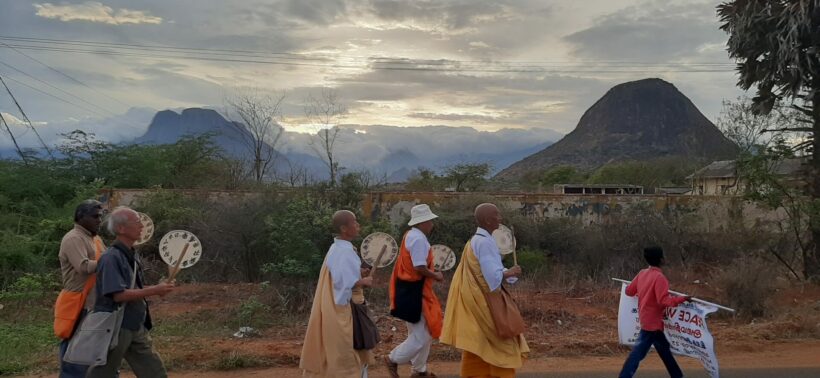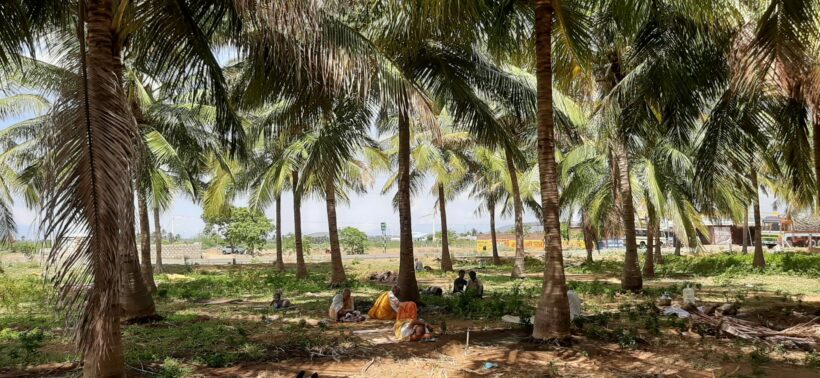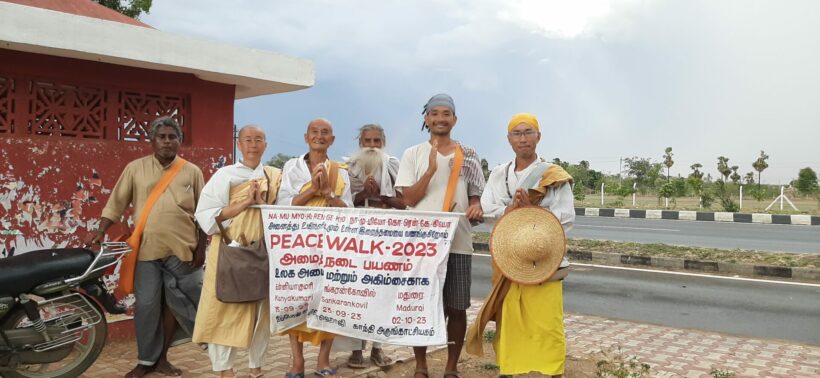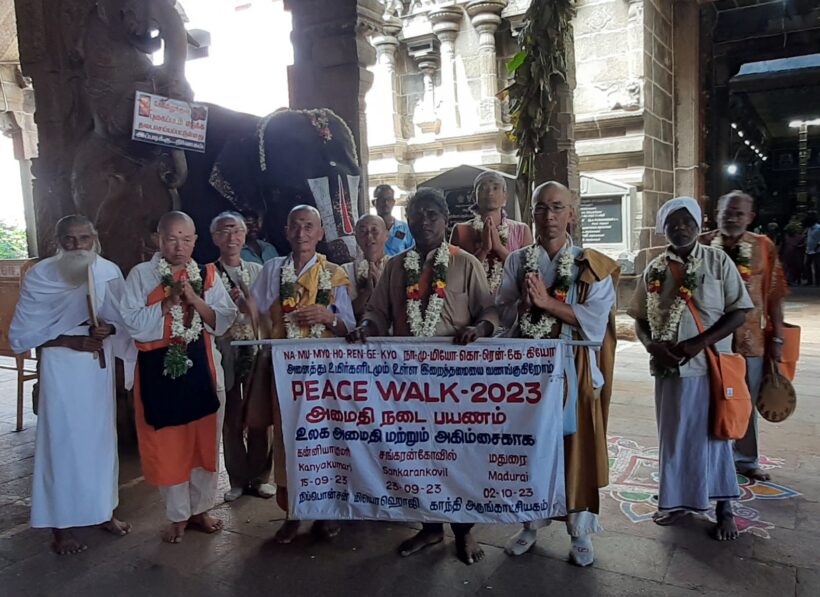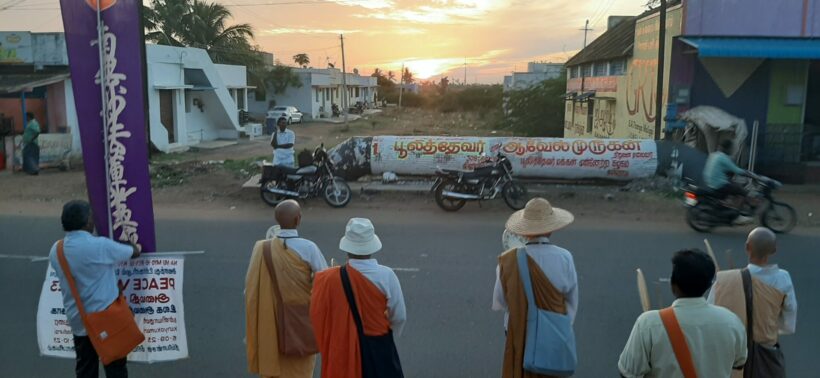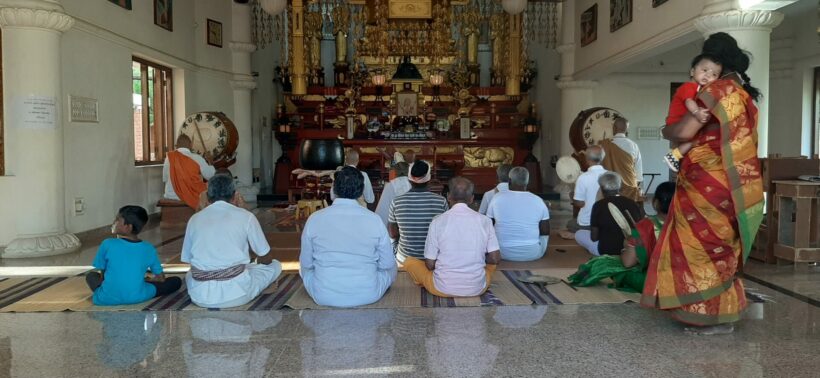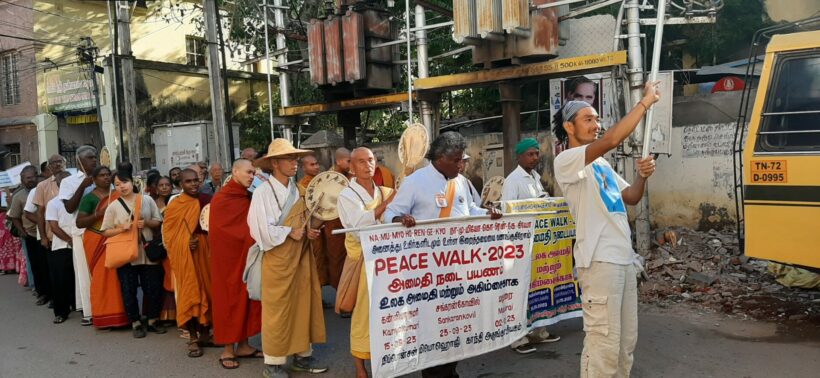September 15th Kanyakumari – September 23rd Sankarankovil – October 2nd Madurai
“Na Mu Myo Ho Ren Ge Kyo ”
Bhikkhu Masao Ishitani made a vow of the South India Gandhi Peace Pilgrimage, from Kanyakumari on September 15th to Madurai, culminating on October 2nd, the birthday of Mahatma Gandhi. Bhikkhu Ishitani extended his invitation to me to join the pilgrimage so I flew in from Europe and arrived at Kanyakumari on the eve of the departure. When I reached the Swami Ramananda Sant Ashram, the gathering point of the pilgrimage, I saw Bhikkhu Ishitani, Bhikkhuni Chigusa Kimura, Bhikkhuni Leelavathi along with Bhikkhu Bhuwan from Rajgir and Bhikkhu Kanshin Ikeda who had come from the pilgrimage in the Caucasus Mountains he was undertaking. These ordained monks and nuns alongside the lay participants were to greet the temple of the Ashram by beating the taiko drum. It was that moment I arrived.
Among the members of this pilgrimage group, there were individuals with a diverse range of backgrounds; for instance, Mr. Kumar, the son of the late Mr. Tanaraji, a Christian principal of a local high school, who had written a letter 45 years ago to the Most Venerable Nichidatsu Fujii requesting the construction of a peace pagoda in the holy land of Kanyakumari. There were also those who had established connections with Bhikkhu Ishitani from his entry into Tamil Nadu 40 years ago. On the other hand, there were participants who had no prior connections with Nipponzan Myohoji. For them it was their first time chanting “Na Mu Myo Ho Ren Ge Kyo ” and they had never held a prayer taiko drum before. It was a unique mix of people, each with their own experiences and expectations.
On the first morning, heavy rainfall made it seem unlikely that we would be able to perform the sunrise worship at dawn. However, by the time we had finished the morning service and packed our belongings, the rain had lessened to a light drizzle. By the time we reached the Kanyakumari Cape, even the thick clouds that had covered the entire sky were lifting slowly. This allowed us to worship the sunrise at dawn at the tip of the cape where the Bay of Bengal, the Arabian Sea, and the Indian Ocean converge. Looking back now, it appears to have been an auspicious sign of the beginning of this pilgrimage.
We visited the Gendai Houtou (a wooden pole stupa inscribed with the Odaimoku in four directions) that had been constructed in the inland region of Kanyakumari. After paying our respects with flowers and incense in this sacred land, we set our course for our first lodging place in Nagarkovil, to the northwest. I wondered then how this visit to the stupa in the middle of that vast open lot, was perceived by the eyes of the members who had no prior connection to Nipponzan Myohoji or the practice of reciting the Odaimoku.
As I saw it, some of the participants seemed to be interested in taking baths and in visiting local Hindu temples when the opportunities arose during the breaks, rather than in learning the Odaimoku, the prayer we were chanting while we walked. Among them, there were those who found it difficult to beat the taiko drum in the right cadence and enunciate the Odaimoku properly. So I showed and taught them repeatedly. Every time an untimely voice or disrupting rhythm of drum beat erupted at the rear of the procession, I would go back to where the person responsible was and say over and over again, “Get in sync!”, sometimes going so far as to say, “Learn them now!” My continuous insistence might have frustrated them. At one point, one responded, “We respect your Japanese prayers, and this Buddhist taiko drum, but we came here to walk. We came for pathayathirai (a Sanskrit term meaning pilgrimage, commonly used by Tamil people, “patha” means foot, “yathirai” means journey). Please, understand that.” I simply replied, “It is more enjoyable and satisfying to synchronize and harmonize.” Since that point, I focused on my own chanting, as long as an entirely different cadence of the drum beat did not break out.
In the first few days after our departure we walked through tropical rainforest-like terrain near the state of Kerala. We encountered heavy rain on a few occasions. However as we entered the inland region of Tamil Nadu, we experienced days of relentless sunshine, with temperatures exceeding 30 degrees Celsius, even before 8 a.m. We prayed at sunrise, walked for an hour or two and already we were soaked with sweat. On such days, I continued to drink more water during the day than could fit in my shoulder bag. It would have been a much more grueling pilgrimage if it weren’t for the accompanying support vehicle. I would like to take this opportunity to express my gratitude to all who were involved in planning this peace pilgrimage, as well as those who provided logistic support from behind the scenes, including Bhikkhuni Leelavathi and Mr. Nanda Rao, the director of Madurai Gandhi Memorial Museum, as well as the local Sarvodaya members and local supporters. Thank you for your assistance in making this peace pilgrimage possible.
Well, on the ninth day of the pilgrimage, we arrived at Sankarankovil city as planned. Local supporters joined our procession, and as we reached the entrance to the Nipponzan Myohoji Temple, a line of people formed to welcome our arrival. The procession grew to more than 100 people. Despite the relentless sunshine, we stood in awe of the 40-meter tall, pure white peace pagoda that reached towards the deep blue sky of South India.
It seemed that our members who were unfamiliar with a Peace Pagoda could imagine the transformation of that semi-arid land in Kanyakumari into a lush environment filled with trees with green leaves and colorful flowers, where sparrows flew and peacocks paraded around the pagoda.
After saying our prayer at the Peace Pagoda, a solemn ceremony was held for the foundation stone of the Fujii Guruji – Gandhiji Peace Memorial Museum, followed by the unveiling of the statue of Gandhi. In his sermon, Bhikkhu Ishitani spoke about the encounter between Fujii Guruji and Gandhi, and the bond they cultivated. It appeared to me that the sanctity of the Odaimoku and the power of each drum beat gradually permeated the hearts of our pilgrimage members.
The reason I say this is that as we entered the second half of our journey, the number of participants who joined midway increased, and our pilgrimage group doubled in size. It was the pilgrims who had walked the first half of the journey from the beginning that took the initiative to teach the newcomers how to beat the taiko drum and chant the Odaimoku properly, so we could harmonize in our pilgrimage. Occasionally, they would seek confirmation from me, and each time I would make minor corrections, saying, “The proper articulation of the Odaimoku prayer is `Na Mu Myo Ho Ren Ge Kyo´. It is `Ge´ instead of `Ke´ (the Tamil pronunciation of `G´ sounds like `K´). I would then respond with “Sabash” (in Tamil means “well done” ). To be honest, I found it quite amusing in my heart.
Many of the Tamil pilgrims on this journey were Hindus. While they joined us in paying respects to the Sankarankovil Peace Pagoda and chanted the Odaimoku with us during the pilgrimage, it does not necessarily mean that they adhere to Buddhism. They would look for Hindu temples nearby, and spend their entire break time there if the occasion allowed, and this continued throughout the whole pilgrimage. They were religious Hindu devotees who simply paid respectful homage to Bhikkhu Ishitani, Bhikkhu Bhuwan, Bhikkhu Ikeda, Bhikkhuni Leelavathi and Bhikkhuni Kimura, and followed them on foot.
In pure Tamil, unaffected by Sanskrit influence, the “peace pilgrimage” can be translated as “amaithi vazhi nadai payanam” where “amaithi” means peace, “vazhi” means path, “nadai” means foot, and “payanam” means journey. I was told that the word “nadai” is more commonly used as a verb than a noun. These lay Tamil pilgrims, as a matter of fact as they put it, “came to walk” behind the ordained individuals, not necessarily to follow the Buddha or the Odaimoku but to follow these Bhikkhu and Bhikkhuni, that is to say, to follow the path they have attained through the monastic Sangha.
We continued our pilgrimage, captivated by the mystical power evoked by the beat of the taiko drum. When we reached Aralvaimozhi forest in the evening, as the trees on both sides of the road covered the sky above with their branches and leaves, a large flock of bats fluttered and chirped above us, giving me an impression as if they were in sync with the drum beat, and when we reached a more open part of the road with a clear view of the sky, it was replaced by a flock of blackbirds that also chirped as they flew overhead. This continued a few times, seemingly the bats and birds were taking turns to sing and dance above our heads in response to the sound of the taiko drum.
The rain that had started just before we entered Vannikonendal gradually intensified, and before reaching our destination for the day, it had transformed into a thunderstorm accompanied by quite a lot of lightning. The thunder we could hear from behind us was drawing nearer. It seemed to be guided by the beat of the taiko drum. Lightning streaked across the sky ahead of us, and when the thunder began to roll, we stopped in our tracks and sought shelter under the roof of a roadside hut. We stowed the taiko drum in our shoulder bag, folded the Gendaiki i.e. Odaimoku banner, and exchanged laughter, saying things like, “Well, we are completely drenched, aren’t we?” As we were sitting there, sparks of light reminiscent of small fireworks burst from the steel pole of a road sign in front of us. Then came a deafening roar. After that, the sky continued to light up in both near and far distance, and the thunder rumbled irregularly and disharmoniously. While there was no rhythm to the thunder, it felt strangely as if it were mimicking the rhythm of the taiko drum that had been sounding just moments before.
On the morning we departed from Rajapalayam, the sunrise to which we prayed at dawn brought light to a line of long thin clouds that was lying parallel to the horizon just above it. As we advanced walking, a series of even thinner lines of clouds dangled down from the parallel line of clouds just like weeping branches. They started to twist and turn, resembling Sanskrit calligraphy being inscribed in the sky. Intrigued by this phenomenon, I continued to beat the taiko drum. As we proceeded even more, the group of round clouds in the sky above began closing their distances, creating a pattern that appeared to be some kind of Tamil script. It became increasingly fascinating, and I intensified my taiko drumming.
With each beat of the taiko drum, more clouds dangled down from the parallel line of clouds above the horizon, and the overhead clouds continued to spin more, appearing to hail with the rhythm of the drum. The Most Venerable Nichidatsu Fujii once said, “The sound of the drum resonates throughout the vast, boundless universe, reaching every corner, across all the three thousand, great and small, worlds in the hundred billion solar system, having them all simultaneously resound with the beat of the drum.” If only we could decipher and enunciate the characters that began appearing on the horizon and in the sky, I was convinced, without any particular basis, that we would hear the prayer “Na Mu Myo Ho Ren Ge Kyo.” However, I surrendered to my own imagination, thinking, “The resembling Tamil characters of the rotating clouds in the overhead sky must sound `Na Mu Myo Ho Ren Ke Kyo´ in terms of pronunciation.” I remember that I could not help but smile.
On the final day of our pilgrimage, we walked through Madurai city. The Gandhians and peace activists also joined us carrying a framed portrait photo of Mahatma Gandhi and the Indian national flag. The procession headed together to the Gandhi Memorial Museum for the grand finale. A visit to Gandhi’s grave and his birthday commemoration ceremony were held in a splendid manner. After attending a series of ceremonies, we made our way to the Nipponzan Myohoji Madurai Temple, where we reported the completion of this South India Gandhi Peace Pilgrimage before the altar. On that special occasion, the pilgrimage participants, the peace walkers as he called us, received heartfelt words of gratitude from Bhikkhu Ishitani, “As a Japanese Buddhist, I must sincerely repay India for the grace of Buddhism that has been gifted to us. I am grateful to you all peace walkers for the opportunity to offer our prayers together through the sky and soil of India during this pilgrimage. Thank you very much”
Bhikkhu Ishitani, affectionately and with great respect called “Periya Samy” (meaning “the great saint” in Tamil) by the locals, led this approximately 350 km pilgrimage at the age of 82, wearing his famous flip flops. Bhikkhuni Kimura, known as “Sinna Samy” (meaning “the young saint”), played a key role as a liaison between the group of pilgrims and the outside world, including interpreting Periya Samy’s Dharma speeches in Tamil throughout the pilgrimage. I am sincerely grateful.
Finally, as we passed through Nanguneri, the tropical rain stopped and a rainbow appeared. During a break, we took a photo with the rainbow in the background. Although the rainbow itself does not show up in the photo, the play of light from behind clearly outlines the figures in the picture. I believe that the sound of the taiko drum will vividly reveal the outline of the memories of this peace pilgrimage, just as the rainbow light is playing in the photo. I am genuinely delighted.
With palms together in peace,
Mitsutake Ikeda
